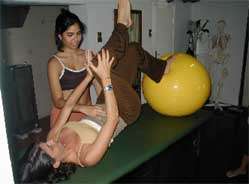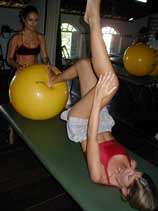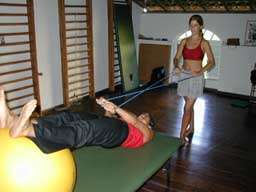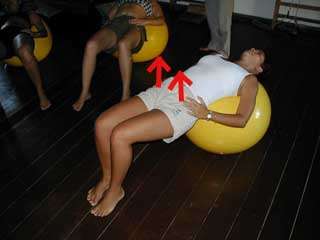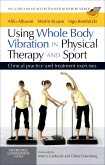Bridging and Pilates Reformer exercises for "Core Stability"
Essential Principle:"the tail must not wag the dog" = must not loose control of the 'neutral zone' of the spine
therefore the peripheral musculature may need to be long and strong, whereas the core (stabilizing) musculature may require endurance
Good exercise prescription takes into account whether the person is functionally unstable due to weakness, stiffness or hypermobility
- goal should be to create static and dynamic pelvic symmetry
- aim is to increase the intermusular and intramuscular neural control between the deep and superficial muscles as well as between and within the superficial muscles themselves.
- the superficial muscles may need to learn to be more efficient by working sub-maximally and therefore better able to rapidly switch off (note that the training effect of improving strength should lead to low relative sub-maximal effort e.g assume that pre-training a muscle can maximally lift 100N and habitually does a task requiring 70N (70%MVC), after training they may be able to maximally lift 210N and hence the task of 70N represents only 30%MVC, which suggests that the task can now be carried out for longer before the onset of fatigue)
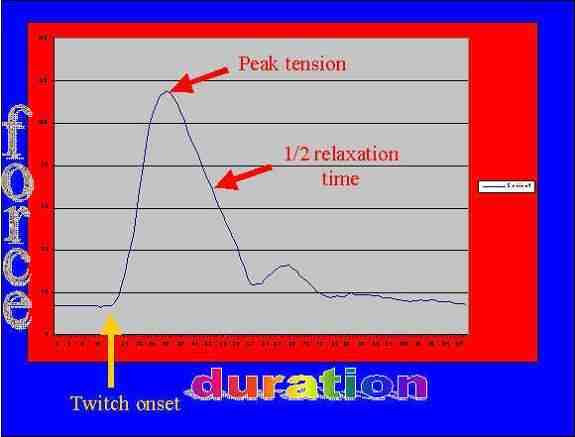
- must begin from a point of stability and gradually work to points of challenging stability
- under optimal conditions it requires up to 16 weeks to develop good endurance and 6- 12 weeks to develop strength and co-ordination
co-ordination and timing of core muscle synergistic interaction is essential and includes dynamic control by
- Transverse Abdominis
- Internal Oblique
- Latissimus Dorsi
- Multifidus
- Piriformis
- Obturators
- inferior Gluteus Maximus
- anterior, mid and posterior portions of Gluteus Medius
- Iliacus
- medial Psoas Major
- medial Quadratus Lumboum
otherwise the prime movers (eg hamstrings, psoas major, rectus femoris, pectoralis major) could move the body in an uncontrolled manner creating damaging torques to the vertebrae
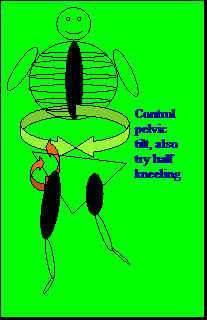
awning and sling effect by the hip muscles on the pelvis
Examine the pelvic control of the deep hip flexors, deep hip rotators - remember these are endurance, low threshold muscles and therefore may need several repetitions of movement to ascertain any compensatory use of ballistic, fast twitch, superficial muscles such as superior gluteus maximus, external obliques, rectus abdominis, rectus femoris and hamstring muscles.

- examine the conjoint tendon and symphysis pubis in lying and standing (hip hitches/drops)
- examine active SLR for pelvic control (pubic symphysis - osteitis pubis)
- examine Thomas's test and Patrick's Faber test
- examine PKB for any quadriceps, patellofemoral dysfunction, femoral nerve dysfunction which causes pelvic rotation
- palpate SIJ
- examine hip internal rotation and it's affect on the sacrum and hence contralateral SIJ
- timing of gluteus maximus : hamstring action (they should not be hamstring dominant)
- examine counternutation by palpating the ischial tuberosity in prone (and ascertain whether MET through the hamstring can ameliorate any asymmetry)
- examine the stork test for SIJ movement and hip lateral stability
- examine gait for inferior gluteus maximus activation/stabilisation at heel strike, and gluteus medius posterior, then medial and then anterior activation/stabilisation during stance
- examine the latissimus dorsi/erector spinae and contralateral gluteus maximus synergy (modified hip hitch/drop)
Control over low threshold loading needs to be attained before Swiss Ball bridging exercises are implemented
( link to anatomical picture of back muscles )
remember to use your ' clinical reasoning ' process to determine the relevance of specific findings to the entire clinical picture
|
core stability with rhythmic stabilizations |
core stability with transverse abdominis work + knee flexion/extension |
 |
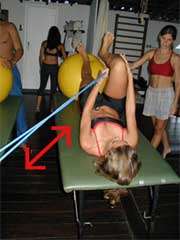 |
| theratubing may be used in functional movement patterns (e.g. emphases on the powerful movement of a swimming stroke or the aspect of the stroke which is taxing the core stability the most) | |
|
additionally, the peripheral nerves need to be able to move amongst the tissue with which they interface |
core stability with straight leg raising (SLR) |
|
hip extension through gluteal work, without losing the 'neutral zone' of the spine (tight hip flexors or rectus femoris may prevent good lumbo-pelvic alignment)
|
|
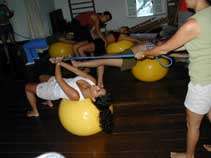 |
 |
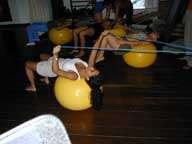 |
| functional theratubing exercises whilst stabilizing on the Swiss Ball | ||
-
with the deep joint stabilizing muscles providing the stability, the 'prime movers' may provide the 'action'
-
generally speaking the stabilizing muscles of most peripheral joints are 'single joint muscles' with an endurance function ('shunt muscles'). These muscles are usually close to the joint (e.g. Iliacus, Obturators, Gluteus Medius and Minimus, inferior Gluteus Maximus, Quadratus Femoris), however in the spine and scapula they cross more than one joint (e.g. Transverse Abdominis, Internal Oblique, Trapezius, Serratus Anterior)
-
the prime movers are the muscles which lend power to the movement e.g. Hamstrings, Rectus Femoris, Superior Gluteus Maximus/ITB/Vastus Lateralis, Rectus Abdominis and External Oblique. Therefore when designing an exercise regime the client must begin with good muscular stability before commencement of training of the prime movers.
-
rotation is essential for ADL, however it must be controlled by synergistic action between muscles
-
frequently, clients compensate for lack of stability by increasing the speed at which they do the task. This then leads to further in-coordination, poor timing between muscles, loss of synergy, and more dysfunction.
"Optimal stability is achieved when the balance between performance (the level of stability) and effort is optimized to economize the use of energy" (Vleeming et al 2004)
"Non-optimal joint stability implicates altered laxity/stiffness values leading to increased joint translations resulting in new joint position and/or exaggerated/reduced joint compression, with a disturbed performance/effort ratio" (Vleeming et al 2004, 5th Interdisciplinary World Congress on Low Back and Pelvic Pain)
Pilates Reformer Exercises
Pilates Reformer exercises can be used to gain optimal control between the lower and upper limbs whilst maintaining control over the pelvis and core. We frequently use the Reformer bed as an interim progression between 'floor exercises' and 'Swiss Ball exercises'. Specific one-on-one exerices with the use of EMG biofeedback and Real-Time Abdominal US can be useful to encourage acurate cognitive processing of the individual components of the task. This is usually done in conjunction with 'hands on' treatment using "Muscle Energy techniques" to ensure symmetrical loading of the spine, hip and pelvis.
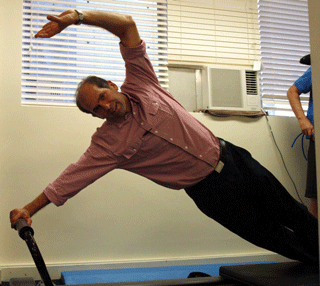
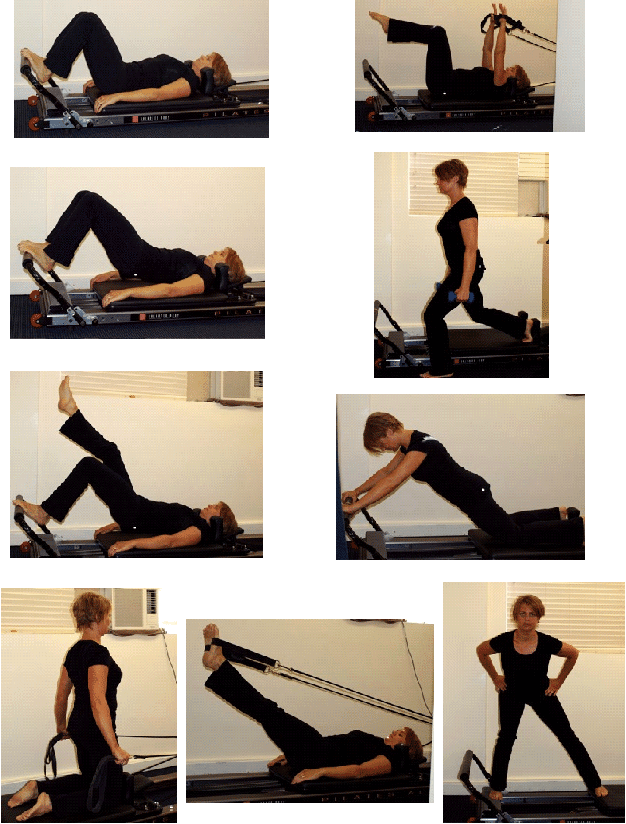
Further Options include Whole Body Vibration by Alfio Albasini and Martin Krause
Anatomical pictures of back muscles, biomechanics and principles of synergy
Last update : 29 December 2016





